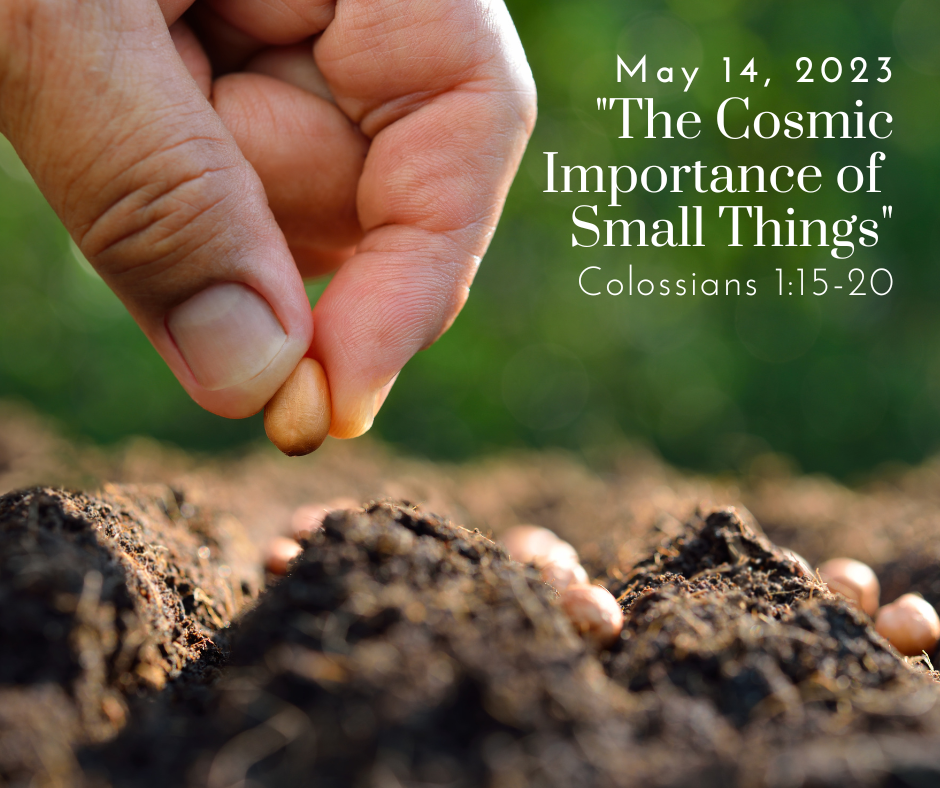[Christ] is the image of the invisible God, the firstborn of all creation, for in him all things in heaven and on earth were created, things visible and invisible….
Jesus the Christ is cosmically significant. In what sounds like an early hymn, the author of Colossians proclaims the loftiest view of Christ in the New Testament. Calling Jesus of Nazareth "Christ" lifts him beyond a great person in history. In modern terms, the writer says this Jewish carpenter, a subcontractor, who was also a charismatic rabbi, is the key to understanding God's hope for the universe. In his life, teaching, death, and resurrection, all things find meaning and energy in God's purpose. That is cosmic!
What do you think of when I use the word "cosmic"? I remember astronomer Carl Sagan's show "Cosmos,” the most watched PBS show ever. Sagan appeared on Johnny Carson's Tonight Show 26 times. In his first episode, Sagan stood over a pounding waterfall and said, "The size and age of the universe are beyond human understanding, lost between immensity and eternity….Our species is young and curious and brave and has made much progress," But our future depends on the scientific work of understanding our world. Sagan was cosmic. Listen to his words which were the inspiration for Joni Mitchell's song "Stardust,"
The nitrogen in our DNA, the calcium in our teeth, the iron in our blood, the carbon in our apple pies were made in the interiors of collapsing stars. We are made of starstuff.
After hearing him speak, I wanted to learn about all the star constellations, and our family bought a telescope. He showed me the world was bigger than Boone, Iowa, and even more significant than Boston, America, or the human species. I didn't become an astronomer, but Sagan did influence my spirituality and view of God. He deeply believed that science led us not to cast God out of the universe but to explore the greatest mysteries of the creative force of all life and consciousness. Therefore, theology must not be reduced to narrow doctrine. Spirituality that is cosmic is more than ritual, positive thinking, or being a better person. We are awed to discover our deep connection to God and all life. How cosmic is that?!
Back to Colossians, how does Jesus of Nazareth go from being a brilliant, witty, and courageous rabbi to the Christ of faith who is the firstborn of all creation? And how would this cosmic view of Christ help us to a growing faith? The original biblical authors had no idea how much creation was out there. They never heard of a galaxy, black hole, or light year. They didn't know the Earth was round and revolved around the sun. Yet a few verses of scripture point to Jesus becoming part of the life force in all things.
Modern scholarship moved away from this kind of theology to the great "Quest for the Historical Jesus." How can we know what is historically true about Jesus? Hundreds of scholars and preachers have sifted through archeological evidence, Greek manuscripts, and historical research to get the most complete and accurate possible picture of who Jesus was so we can understand what Christianity is about. At least ¾ of my sermons follow this path. The thinking was that if we can get a clear picture of the historical Jesus and what he taught, we can get to the true faith.
The value of the quest for the historical Jesus grounds us in human reality and brings Jesus close to us, but maybe too close sometimes. It is often the case that the portraits of the historical Jesus look much like our own highest ideals, rather than letting Jesus speak for himself and challenge and shape us. We create the Jesus we want. Our spirituality also needs a sense of transcendence and awe, that God is more than the best of human reality, even more than what the Jesus of history shows us. We need both the human Jesus and the Cosmic Christ. We need to explore the words of scripture and the wonders of the cosmos to fully seek the Divine. (In John 3:16, which reads, “God so loved the world that he gave his son….” The Greek word for world is cosmos. God so loved the cosmos!)
Colossians does not speak at all about the historical Jesus of Nazareth. The short letter is about the implications of the Risen Christ connecting us to God and showing us God's purposes for all creation. This Christ was together with God in the beginning, then became human at the incarnation, and after death and resurrection, pulls us towards a final union with God. This is Christmas Eve theology. The last reading of the "Lessons and Carols" service is the beginning of John's Gospel:
In the beginning was the Word, and the Word was with God, and the Word was God. 2 He was with God in the beginning. 3 Through him, all things were made; without him, nothing was made that has been made.4 In him was life, and that life was the light of all humankind. And the word became flesh and dwelt among us.
This text describes not just a historical Jesus but a cosmic Christ. The first theologian to use the term "Cosmic Christ" was Teilhard de Chardin, a Jesuit who was also a paleontologist. De Chardin participated in the excavation which discovered the "Peking Man," skull dated at least 230,000 years old. Later discoveries in Ethiopia pushed early human development back to possibly 4 million years. The idea of human origins being so ancient and occurring in stages of evolution created theological controversy in the Catholic Church. Didn't all humans descend directly from Adam and Eve, already created in God's image, just as we are today? Official church doctrine held that the earth was created in one week of 4004 BCE. Archbishop Ussher added all the years of the genealogies of Genesis to get this date. These discoveries of the evolutionary development of humankind were viewed as one more threat by science to dethrone God from the control of the universe. First, we find the earth revolves around the sun, and we aren't the center of the universe. Gravity spins the planets, taking the heavens out of the control of God. What happens to our scriptures if humans were not created in the beginning, but were millions of years later to the party? Soon scientists might challenge the notion that the Pope was infallible.
De Chardin thought this archeological discovery was fascinating and worked to bring together the archeological evidence with faith and scripture. For his efforts, he was silenced by the Catholic Church and ordered not to teach or publish in 1926, a ban that lasted until his death. De Chardin was mainly unknown when he was buried in a monastery graveyard in Hyde Park, NY. His book "The Phenomenon of Man," written in 1941, was finally published after his death in 1957. John XXIII, the reforming Pope, discouraged people from reading it, and Catholic booksellers couldn't carry it.
When I stumbled across his gravesite and read the inscription, I was immediately interested in reading a book so steeped in controversy. The book is profound, controversial, and still relevant today. If you think God's work in humanity began 4 million years ago, not just 4000 BCE, it creates a powerful shift. Think of the investment of time in human development. Ninety-nine percent of human history finally gets us to the point of creating a written language. If you ever wondered whether God has the patience to deal with you, there is proof. De Chardin is eloquent about the wonder of the evolution of not just our bodies but human consciousness. He believes our consciousness is no accident but part of the purpose of creating the universe. Our God-given calling is to continue striving for greater consciousness and understanding of how the universe and all life are interrelated.
Guess what scripture text de Chardin put at the center of his theology. Colossians 1:15-20,
[Christ] is the image of the invisible God, the firstborn of all creation,16 for in[i] him all things in heaven and on earth were created, things visible and invisible….
The Risen, Cosmic Christ, is the key to understanding humanity's divine evolutionary task. The work of God in Jesus of Nazareth was like the splitting of the atom, releasing new spiritual energy into the world. At the resurrection of Christ, love is unleashed with new power which brings greater harmony to all living things. Whatever you do to increase human flourishing in the millions of years project contributes to God's ultimate hope for life.
Here's the end of De Chardin story. His publication spawned new thinking about humanities role in the universe and spurred environmental theology. Pope Francis quoted this once-banned work as the starting point for understanding our place in creation and the spiritual necessity of addressing climate change. If, as Colossians and De Charden says, Christ is the in and part of all things, then we must also add to the Great Commandment to love the earth as we love ourselves. We are in relationship with all living things, who are in Christ as well.
The rehabilitation of de Chardin’s work reminds us that we are constantly working towards things that are much bigger than us and these things take more than our lifetime. But we must persist because the next generations are counting on us. As Sagan said, maybe we need to claim that our species is young and curious and brave, and our next spiritual evolution is to find ourselves in a relationship of love to all of creation.





